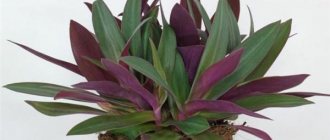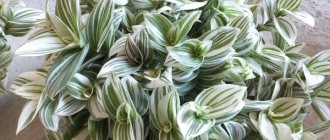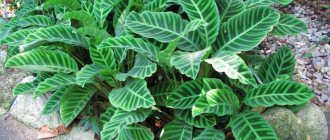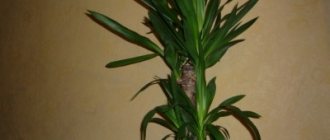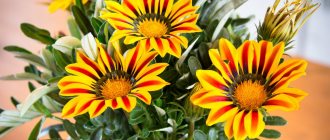The zebrina or tradescantia plant is valued by gardeners for its unique leaf color and ease of care. It is not difficult to recognize it in a greenhouse or on a windowsill: the oblong leaves are decorated with longitudinal stripes, their shades vary depending on the variety. It is no coincidence that the plant received such a name because of its resemblance to an animal.
Description
Tradescantia zebrina belongs to the Commelinaceae family. The herbaceous inconspicuous plant attracted the attention of the gardener John Tradescana, who served at the English court of Charles the First. At that time, the scientist was engaged in the classification of unknown plants on the open continent of America. The traveler began cultivating and growing a creeping representative of the flora, being able to discern in it great prospects in floriculture.
Zebrina is growing quickly. Young erect shoots, as they grow, descend downward; their length can reach 80 cm.
The flowing stems are colored to match the leaves, that is, if the main color of the leaves is purple, then the stem will be the same shade.
The hanging plant surprises with its color range of leaves, the lower side of which is single-colored, the upper side is two-colored. The main color of the leaves can be either green, purple or reddish, with silver, purple, white and pale green stripes clearly visible against its background. They smoothly bend around the central vein, leaving the edge of the leaf dark. The oval-shaped leaves measure 7x3 cm.
Tradescantia indoors blooms rarely. The small flowers, colored purple, lilac or pink, have only three petals. Flowering begins in early summer: delicate flowers appear in the axils of the leaves at the top of the stem, which look very touching.
The falling multi-colored cascade of Tradescantia is popularly called “Woman’s Gossip”, “Mother-in-Law’s Tongue” and others. This indicates the popularity of the plant and the love of gardeners for it.
When and how does it bloom
Tradescantia - types of hanging plants Anderson, Zebrina and others
At home, zebrina rarely blooms.
Types of flowers
It blooms with small pinkish or purple flowers. They bloom at the top in the leaf axils.
Flower shapes
The flowers are radially symmetrical, with two petals. The calyx and corolla are fused-leaved.
Flowering period
In the wild and rarely at home, it blooms from May to the end of August. The flowering period does not cause allergic reactions.
What do Tradescantia zebrina flowers look like?
Trimming
It is necessary to pinch the tops of the side shoots so that the bush is lush, but does not grow too much. Old, dried branches need to be cut off periodically.
Medicinal properties of Tradescantia zebrina
It is impossible not to mention the medicinal properties of zebrina. American folk healers put it on a par with the legendary aloe. Even their healing properties are similar: both are used to treat diabetes.
Zebrina has bactericidal properties. Since ancient times, Tradescantia has been grown in Buddhist monasteries for medicinal purposes. The leaves were crushed, the resulting pulp was applied to bruises, wounds, scratches, and even tumors were treated. Freshly prepared juice cleansed purulent wounds, relieved pain, and was taken for tuberculosis. On the island of Cuba, a decoction of the leaves was used for diseases of the digestive system.
Tradescantia is considered a natural air purifier, not inferior to chlorophytum, callisia and other plants.
The herbaceous plant is a real treat for pets. When cats feel unwell, they eat tender leaves, which replace street medicinal grass for them in the winter. Turtles, birds, hamsters and even fish love to feast on them.
Options for using decorative grass
In ornamental gardening, fan grass is grown for the following purposes:
- decoration of the banks of reservoirs;
- creating compositions;
- shading of other plantings.
It can be planted separately or as part of a flower bed. Sometimes the ornamental grass is used to frame lawns and flower beds.
Miscanthus is used to create compositions on the site
Varieties
Hanging (hanging) (Tradescantia zebrina pendula)
Tradescantia zebrina pendula
The most common and frequently encountered species is the drooping zebrafish. The stems of the indoor plant are bare; they alternately contain egg-shaped leaves, pointed towards the top. Their length is 6 cm, width - 3 cm. On the lower side, the leaf plates are purple, on the upper side, two silver stripes stretch across a green background. Small rare flowers - pink in color.
In the wild, the perennial is found on the Mexican and American mountain slopes; tropical rainforests also have favorable growing conditions.
Purpus (Zebrina purpusii)
Tradescantia Zebrina Purpusa (Zebrina purpusii)
This type of zebrina takes an honorable second place in the popularity of growing indoors. The leaves of the Purpusa variety of Tradescantia are larger than those of the hanging Tradescantia: width – 5 cm, length – 10 cm. Their characteristic feature is the absence of distinct stripes. The leaf plates on the upper side, like the stem, have several shades - reddish, olive, green; on the lower side they are purple. The leaves are pubescent on the outside and bare underneath.
The color changes depending on the amount of sunlight: in partial shade the reddish tint almost disappears, leaving a green-olive tint; in the sun, on the contrary, a purple-olive tone is pronounced.
Zebrina purpuss blooms with purple flowers.
Under natural conditions, the herbaceous crop grows on rocky mountain slopes, high above sea level (400 - 500 meters), in the savannas of Mexico.
Flocculosa (Zebrina flocculosa)
Tradescantia zebrina flocculosa (Zebrina flocculosa)
The rarest specimen of Tradescantia grown by gardeners. The fuzzy soft green leaves with a white tint are soft to the touch. The blue flowers have three petals with white stamens in the middle.
Hanging four-color
It is characterized by a specific and lush color of the leaf blades. In the core area they are painted green with a metallic tint, and the frame consists of green-red and whitish stripes. The leaves have a purple tint at the bottom.
You can see what the Zebrina Four-Color variety looks like in the photo below:
Zebrina Quadricolor
Home care
Caring for a zebra is not difficult. Even an inexperienced gardener can grow this representative of the flora.
Selection of soil and location
The plant is quite light-loving. The ideal place for its growth would be windows facing east or west. The brightness of the color is best seen in diffused light.
Zebrina is psychic in terms of where it grows. A bad area in the room will affect the appearance of Tradescantia: the plant becomes pale and stunted.
There is a popular belief that in a house where a zebrafish grows there is a good family atmosphere, comfort and tranquility.
For herbaceous perennials, the soil mixture should be prepared in the following ratio: leaf soil (2 parts), one part each - humus, sand and turf soil. You can use a purchased soil substrate for variegated plant crops, diluting it with sand - a quarter of the required soil volume.
Fertilizers and fertilizers
Feeding should begin in the spring, during the period when Tradescantia begins to actively grow. Complex fertilizers must be applied once every two weeks. There is no need to feed the flower in the autumn-winter season. Fertilizer should not be applied immediately after transplantation or if the plant is “sick”.
When using organic matter, you need to know when to stop: excess humus will lead to loss of “striped” color.
Landing
It is better to choose a pot for planting that is wide but shallow, since the root system of Tradescantia is located near the surface. The container must have drainage holes. The best option is a ceramic pot that allows air and water to pass through. Plastic pots do not have such qualities, so you need to loosen the soil in them much more often.
Pour expanded clay into the bottom of the pot, or small pebbles or polystyrene foam to prevent moisture stagnation. Fill in the prepared soil mixture and moisten it.
Cut shoots are good material for planting. The tops quickly take root. It is recommended to plant 5–7 cuttings at once in one pot so that the plant will bush in the future. Cover the planted cuttings with a transparent bag. With this greenhouse effect, planting material will take root faster. You don’t have to cover the plant, but simply shade it.
Zebrina: replanting an indoor flower
Tradescantia Zebrina: flower photo
Indoor Zebrina looks beautiful and performs its decorative functions during the first three years of life. Then the plant no longer has an attractive appearance, and, as a rule, it is replaced with a younger plant. Therefore, no one is replanting the bush. You can only go into more detail on the landing rules.
For this plant, the optimal composition will be soil containing leaf soil, turf soil in equal proportions, and 1 part sand.
Reproduction methods
There are several ways to propagate Tradescantia.
Seeds
This is the most labor-intensive way to grow zebrina. In spring, the seeds must be sown in a container with soil; there is no need to deepen them much. Moisten the soil and cover the top of the container with glass or film. Place it in a warm, bright place where the temperature does not drop below +20 degrees.
The home “greenhouse” must be regularly ventilated to avoid the formation of condensation. When seedlings appear, remove the cover, monitor the soil moisture, and prevent it from drying out. Plant the strengthened plants in flower pots.
Cuttings
You can prepare planting material yourself by cutting off the tops of shoots with 4-5 leaves in adult plants. To get a lush bush, it is better to take not one cutting, but several. You can root the shoot first in water and then plant it in the ground. Or you can immediately plant the cuttings in the ground, covering them with a bag to create a greenhouse effect.
Cuttings take root quickly - within two weeks, after which remove the shelter. When they grow, they are planted in an individual pot.
Dividing an adult plant
If Tradescantia has grown greatly, then you can divide a large bush into several small ones. It is better to perform this procedure when replanting so as not to damage the roots. Each new part of the plant is planted in an individual pot. The newly planted zebrina needs to be shaded for several days, and it needs moderate watering.
Bloom
Tradescantia rarely blooms at home, but many gardeners say that when comfortable conditions are created, small flowers with three petals of bright colors appear on the shoots.
Zebrina flower in the photo:
Possible problems
If indoor Tradescantia begins to look different from usual, then you need to pay attention to its care and eliminate mistakes.
- the shoots are bare, the foliage has become sparse: the plant lacks water and nutrients;
- the color of the foliage has lost its variegation: there is little light;
- foliage withers, turns yellow: from lack of moisture;
- the tips of the leaves dry out: due to too dry air in the room;
- Drooping, thinned leaves become watery: the soil has been flooded or dried out. If the soil is dry, watering will save Tradescantia; if the soil is over-watered for a long time, problems with the roots will arise. In this case, it is better to cut off the shoots and root them in a new container.
Botanical features of miscanthus and optimal conditions for its cultivation
The perennial plant can reach a height of 80 to 200 cm; the fan root system is creeping and loose. The stems are erect, the leaf blades are linear and very rigid. The panicles of the cereal have long lateral branches, and the spikelets form 1 developed flower. Miscanthus has a long growing season, which means it needs temperatures above 20 ºC for enhanced growth and development. And the plant also needs fertile soil to support life processes.
Botanists believe that the homeland of the grass is the territories of Japan, Korea, and Manchuria. Wild grass is also found on the east coast of the USA and the Southern Kuril Islands. In the middle of the last century, breeders paid attention to miscanthus and began long-term work on the plant.
General information:
Zebrina is a creeping succulent perennial low-growing herbaceous plant belonging to the Commelionaceae family.
Mexico and Central America are considered the homeland of this plant. Zebrina stems are creeping shoots covered with foliage. The stems of a young plant are straight, while those of a more mature plant creep over time. Zebrina's leaves are unique, have stripes, which in turn have different shades: green, red, silver, white. The shape of the leaves is pointed, ovoid.
Zabrina's flower consists of a calyx and a corolla. The color of the flowers can be pink, purple and lilac. The flower itself has an inconspicuous appearance. The plant gets its decorative appearance from its surprisingly striped leaves. The flowering process occurs very rarely.
The stem of this plant has the ability to take root at its nodes, this leads to the growth of the flower. Zebrina is considered a medicinal plant and is often used for medicinal purposes. But most often Zebrina is grown to purify and refresh the air in the room, because this plant copes with this function very well.



